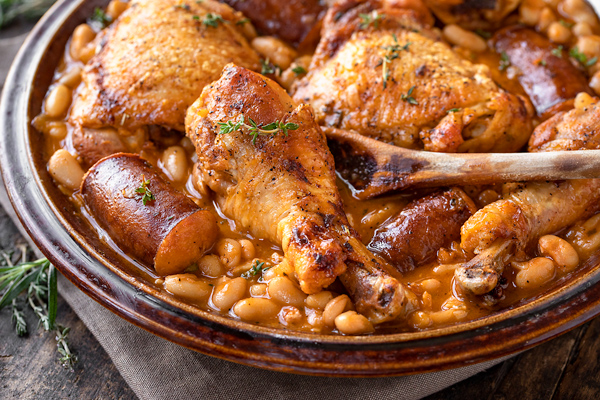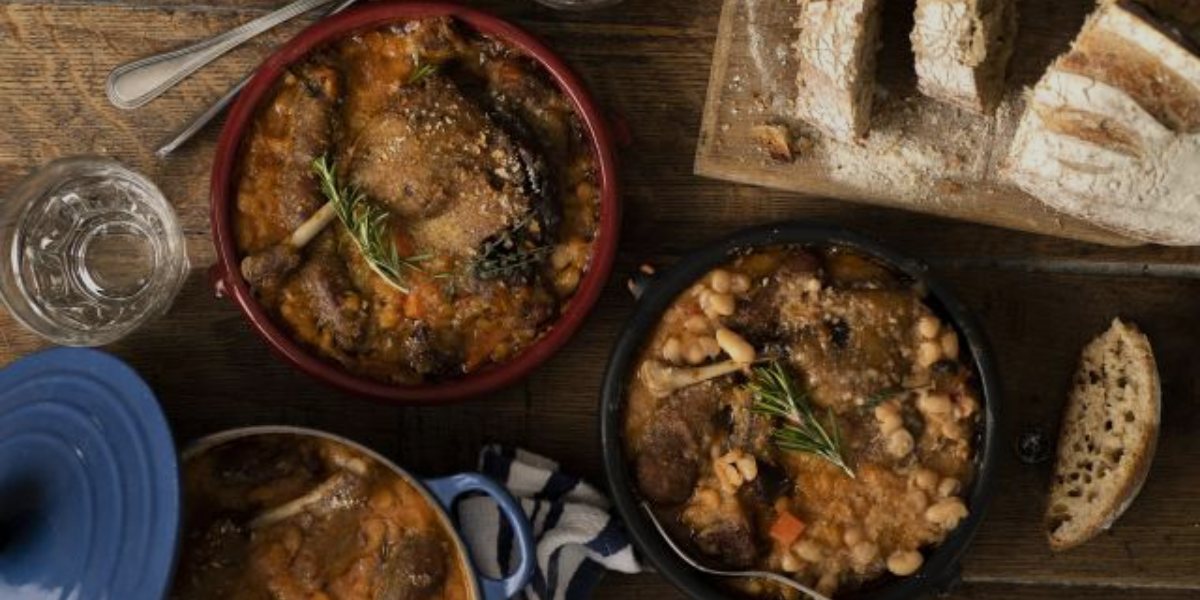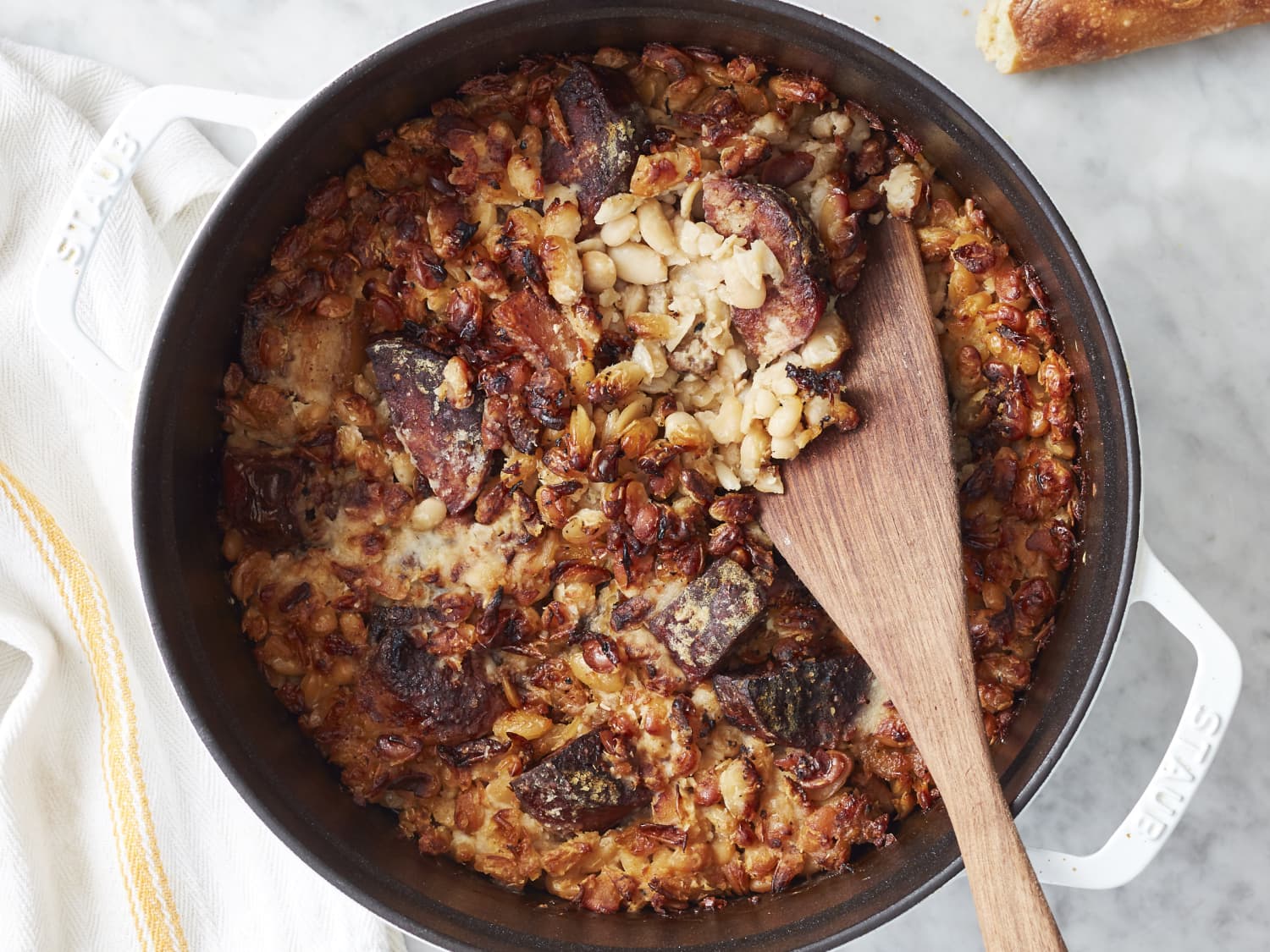In the realm of French cuisine, few dishes evoke the same level of rustic charm and hearty satisfaction as cassoulet. This iconic French casserole, originating from the region of Occitanie, is a celebration of slow-cooked comfort, blending an array of meats, beans, and aromatic herbs into a sumptuous culinary masterpiece. Let’s delve into the fascinating history and tantalizing flavors of this beloved dish.
A Taste of History:
Cassoulet’s roots can be traced back to the medieval town of Castelnaudary in southern France, where it was born out of necessity and ingenuity. Legend has it that during the Hundred Years’ War, the residents of Castelnaudary, faced with a siege, pooled their meager resources to create a hearty stew using local ingredients such as beans, pork, and duck. This humble dish evolved over the centuries, eventually becoming the revered cassoulet we know today.

The Essential Ingredients:
At the heart of cassoulet lies a trio of essential ingredients: beans, meat, and aromatic seasonings. While recipes may vary from region to region, the traditional cassoulet typically features white beans (such as haricot beans), along with a combination of meats such as duck confit, pork sausages, and sometimes lamb or pork shoulder. Garlic, onions, carrots, tomatoes, and bouquet garni (a bundle of herbs) add depth and complexity to the dish.
The Art of Layering and Slow Cooking:
One of the hallmarks of cassoulet is its methodical preparation, which involves layering the ingredients in a deep earthenware pot known as a cassole (hence the name “cassoulet”). The beans are cooked slowly with the meats and aromatics, allowing the flavors to meld together and the sauce to thicken to a rich, unctuous consistency. This slow-cooking process is essential for achieving the signature depth of flavor and tender texture that defines cassoulet.
Regional Variations:
While Castelnaudary, Carcassonne, and Toulouse are considered the holy trinity of cassoulet-making cities, each region has its own unique spin on the dish. In Castelnaudary, the classic cassoulet features duck confit, Toulouse sausages, and pork shoulder. Carcassonne’s version often includes lamb and partridge, while Toulouse favors the use of pork and sausage. Regardless of the variation, the essence of cassoulet remains the same: a soul-warming tribute to the bounty of the French countryside.
Serving and Enjoying:
Cassoulet is best enjoyed piping hot, straight from the oven, with a crusty baguette and a robust red wine such as a Cahors or Côtes du Rhône. The rich, hearty flavors and comforting textures make it the perfect centerpiece for a cozy family meal or a festive gathering with friends.

Here’s a simple recipe for cassoulet:
Ingredients:
- 2 cans (15 ounces each) of white beans (such as cannellini or Great Northern), drained and rinsed
- 4 duck legs confit (you can find these pre-made at specialty stores or online)
- 4 pork sausages (such as Toulouse sausages)
- 1 onion, diced
- 2 cloves garlic, minced
- 2 carrots, diced
- 1 can (14.5 ounces) diced tomatoes
- 2 cups chicken or vegetable broth
- 1 bay leaf
- 2 sprigs thyme
- Salt and pepper to taste
- Bread crumbs (optional, for topping)
Instructions:
- Preheat your oven to 350°F (175°C).
- In a large oven-safe pot or Dutch oven, heat a bit of olive oil over medium heat. Add the diced onion, garlic, and carrots, and sauté until softened, about 5 minutes.
- Add the diced tomatoes with their juices to the pot, along with the drained and rinsed white beans. Stir to combine.
- Nestle the duck legs confit and pork sausages into the bean mixture.
- Pour the chicken or vegetable broth over the ingredients in the pot. Add the bay leaf and thyme sprigs. Season with salt and pepper to taste.
- Cover the pot with a lid and transfer it to the preheated oven.
- Bake the cassoulet in the oven for 1.5 to 2 hours, or until the meat is tender and the flavors have melded together. If desired, sprinkle bread crumbs over the top during the last 15 minutes of baking for a crunchy topping.
- Once done, remove the cassoulet from the oven and let it rest for a few minutes before serving.
- Serve the cassoulet hot, spooning the bean and meat mixture into bowls.

Here are some interesting facts about cassoulet:
- Ancient Origins: Cassoulet’s roots can be traced back to the Middle Ages, where it was believed to have originated in the Languedoc region of southern France. It was traditionally a peasant dish, made with locally available ingredients such as beans, meats, and vegetables.
- The Three Musketeers Connection: Cassoulet is famously associated with the city of Castelnaudary, which claims to be its place of origin. In Alexandre Dumas’ novel “The Three Musketeers,” the character D’Artagnan is said to have enjoyed a hearty serving of cassoulet during his travels.
- Three Cities, Three Variations: There are three main cities in the Occitanie region of France that are known for their variations of cassoulet: Castelnaudary, Carcassonne, and Toulouse. Each city has its own unique recipe and combination of meats, beans, and seasonings.
- Slow-Cooked Comfort: Cassoulet is known for its slow-cooking process, which allows the flavors to meld together and the ingredients to become tender and flavorful. Traditionally, cassoulet is cooked low and slow in a cassole, a deep earthenware pot.
- Variety of Meats: While the traditional cassoulet recipe calls for duck confit, pork sausages, and sometimes lamb or pork shoulder, there are endless variations of meats that can be used. Some recipes even include game meats like rabbit or partridge.
- Bean Debate: The type of beans used in cassoulet can spark debate among purists. While white beans like haricot beans are the most commonly used variety, some regions prefer different types of beans such as lingot beans or tarbais beans.
- International Influence: Cassoulet’s popularity has spread beyond France and can be found on menus in restaurants around the world. In the United States, variations of cassoulet are often served in French bistros and upscale eateries.
- Cultural Celebrations: In the Occitanie region of France, cassoulet is celebrated annually with festivals and competitions dedicated to this beloved dish. The most famous of these festivals is the Fête du Cassoulet held in Castelnaudary, where locals and visitors alike gather to indulge in hearty servings of cassoulet.
- Symbol of Hospitality: Cassoulet is often considered a symbol of hospitality and conviviality in French culture. It’s a dish that brings people together around the table to share in its rich and comforting flavors.
- Adaptability: While cassoulet is traditionally made with meat, beans, and vegetables, there are vegetarian and vegan variations of the dish that substitute meat with plant-based proteins like tofu or tempeh. These adaptations allow everyone to enjoy the comforting flavors of cassoulet, regardless of dietary preferences.
(FAQs) about cassoulet:
Q. What is cassoulet?
- A classic French meal, cassoulet is thought to have originated in the Occitanie area of southern France. In this flavorful casserole, white beans are cooked with a variety of meats—duck, pig sausages, and occasionally lamb or hog shoulder—and aromatic spices.
Q. What does the word “cassoulet” mean?
- Traditional cassoulet is cooked in a deep earthenware pot called a cassole, although the name “cassoulet” can also mean the food itself. The original name, “cassole,” has its origins in the Old French phrase for “casserole dish.”
Q. What are the main ingredients in cassoulet?
- White beans (like haricot beans), meats (like duck confit, pig sausages, and occasionally lamb or pork shoulder), fresh vegetables (onions, garlic, tomatoes, carrots), and aromatic herbs (like bay leaf and thyme) are the mainstays of cassoulet.
Q. Where does cassoulet originate from?
- The city of Castelnaudary in the Languedoc region in southern France is commonly thought to be the birthplace of cassoulet. Nonetheless, you may find this meal in a variety of forms in other Occitanie places like Carcassonne and Toulouse.
Q. What is the difference between the cassoulet variations from Castelnaudary, Carcassonne, and Toulouse?
- Although the cassoulet recipes from each of the three towns are different, the key variations are in the meats and seasonings that are utilized. The cassoulet in Toulouse is known for its pig and sausage, but the one in Castelnaudary is more commonly made with pork shoulder, duck confit, and Toulouse sausages.
Q. Is cassoulet difficult to make?
- Although it’s not inherently complex, cassoulet’s slow cooking method can make the dish take longer than expected. The secret is to go gradually and enjoy the tastes as they emerge. There are a lot of steps, but it’s worth it in the end.
Q. Can I make cassoulet ahead of time?
- Yes, cassoulet can be prepared in advance, and it actually improves with reheating the next day. The dish is full of rich, savory aromas and flavors since the components have more time to combine. Before serving, gently reheat the cassoulet in the oven or on the stovetop.
Q. What can I serve with cassoulet?
- Traditional accompaniments for cassoulet include a serving of plain green salad and crusty bread for mopping up the sauce. A bold red wine, like a Cahors or Côtes du Rhône, goes nicely with it.
Q. Is cassoulet gluten-free?
- Since traditional cassoulet does not include any wheat-based components, it is usually gluten-free. To be sure they are gluten-free, though, read the labels of any pre-made items (like sausages or canned beans).
Q. Are there vegetarian or vegan variations of cassoulet?
- You may make cassoulet without meat by using plant-based proteins such as tofu, tempeh, or mushrooms. While accommodating a variety of dietary restrictions, these variations maintain the authentic flavor and robust texture of cassoulet.
Conclusion:
More than just a meal, cassoulet embodies the rich history and distinctive culture of the Occitanie area. Cassoulet has a long history of enchantment among foodies all around the globe, because to its hearty ingredients, varied preparation methods, and taste profiles that satisfy the soul. So why not try making cassoulet for yourself and enjoying the classic dish that has stood the test of time? Good appetite!


